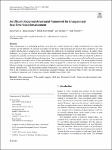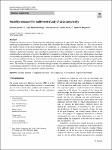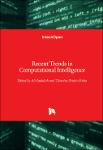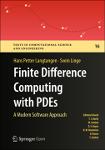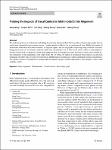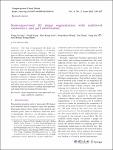Search
Author
- Jorgensen, Ed (3)
- McFadyen, Ron (3)
- Nora, El-Rashidy (3)
- Christian, Homeyer (2)
- next >
Subject
- programming (10)
- Open Access (8)
- Java (7)
- Programming (7)
- next >
Date issued
- 2020 - 2025 (293)
- 2010 - 2019 (39)
- 2000 - 2009 (2)
- 1999 - 1999 (1)
Has File(s)
- true (335)
Search Results
The INTERACT Conferences are an important platform for researchers and practitioners in the field of human-computer interaction (HCI) to showcase their work. They are organised biennially by the International Federation for Information Processing (IFIP) Technical Committee on Human-Computer Interaction (IFIP TC13), an international committee of 30 member national societies and nine Working Groups. INTERACT is truly international in its spirit and has attracted researchers from several countries and cultures. With an emphasis on inclusiveness, it works to lower the barriers that prevent people in developing countries from participating in conferences. As a multidisciplinary field, HCI requires interaction and discussion among diverse people with different interests and backgrounds. T... |
Video enhancement is a challenging problem, more than that of stills, mainly due to high computational cost, larger data volumes and the difficulty of achieving consistency in the spatio-temporal domain. In practice, these challenges are often coupled with the lack of example pairs, which inhibits the application of supervised learning strategies. To address these challenges, we propose an efficient adversarial video enhancement framework that learns directly from unpaired video examples. In particular, our framework introduces new recurrent cells that consist of interleaved local and global modules for implicit integration of spatial and temporal information. |
omplexity measures aim to characterize the underlying complexity of supervised data. These measures tackle factors hindering the performance of Machine Learning (ML) classifiers like overlap, density, linearity, etc. The state-of-the-art has mainly focused on the dataset perspective of complexity, i.e., offering an estimation of the complexity of the whole dataset. Recently, the instance perspective has also been addressed. In this paper, the hostility measure, a complexity measure offering a multi-level (instance, class, and dataset) perspective of data complexity is proposed. |
Computational intelligence (CI) is the philosophy, architecture, execution, and creation of cognitive paradigms that are biologically and linguistically driven. Neural networks, fuzzy systems, evolutionary computation, learning theory, and probabilistic methods are historically the five main pillars of CI. In this book, CI and the applicable nature of CI are highlighted by explaining different practical applications. This book starts with some applications of CI, and then proceeds with the usage of data mining in the field of CI. The book ends with some real-life and practical applications of deep learning in various fields of studies from video detection to patient disease. |
This easy-to-read book introduces the basics of solving partial differential equations by means of finite difference methods. Unlike many of the traditional academic works on the topic, this book was written for practitioners. Accordingly, it especially addresses: the construction of finite difference schemes, formulation and implementation of algorithms, verification of implementations, analyses of physical behavior as implied by the numerical solutions, and how to apply the methods and software to solve problems in the fields of physics and biology. |
We study the problem of multimodal embedding-based entity alignment (EA) between different knowledge graphs. Recent works have attempted to incorporate images (visual context) to address EA in a multimodal view. While the benefits of multimodal information have been observed, its negative impacts are non-negligible as injecting images without constraints brings much noise. It also remains unknown under what circumstances or to what extent visual context is truly helpful to the task. |
This open access book includes contributions by leading researchers and industry thought leaders on various topics related to the essence of software engineering and their application in industrial projects. It offers a broad overview of research findings dealing with current practical software engineering issues and also pointers to potential future developments.
Celebrating the 20th anniversary of adesso AG, adesso gathered some of the pioneers of software engineering including Manfred Broy, Ivar Jacobson and Carlo Ghezzi at a special symposium, where they presented their thoughts about latest software engineering research and which are part of this book. This way it offers readers a concise overview of the essence of software engineering, providing valuable insights into the ... |
Living in a networked world means never really getting to decide in any thoroughgoing way who or what enters your “space” (your laptop, your iPhone, your thermostat . . . your home). With this as a basic frame-of-reference, James J. Brown’s Ethical Programs examines and explores the rhetorical potential and problems of a hospitality ethos suited to a new era of hosts and guests. Brown reads a range of computational strategies and actors, from the general principles underwriting the Transmission Control Protocol (TCP), which determines how packets of information can travel through the internet, to the Obama election campaign’s use of the power of protocols to reach voters, harvest their data, incentivize and, ultimately, shape their participation in the campaign. In demonstrating the... |
The lack of fine-grained 3D shape segmentation data is the main obstacle to developing learning-based 3D segmentation techniques. We propose an effective semi-supervised method for learning 3D segmentations from a few labeled 3D shapes and a large amount of unlabeled 3D data. For the unlabeled data, we present a novel multilevel consistency loss to enforce consistency of network predictions between perturbed copies of a 3D shape at multiple levels: point level, part level, and hierarchical level. For the labeled data, we develop a simple yet effective part substitution scheme to augment the labeled 3D shapes with more structural variations to enhance training. |
Concepts based on psychology fit well with current research trends related to robotics and artificial intelligence. Biology-inspired cognitive architectures are extremely useful in building agents and robots, and this is one of the most important challenges of modern science. Therefore, the widely viewed and far-reaching goal of systems research and engineering is virtual agents and autonomous robots that mimic human behavior in solving known and unknown problems. The article proposes, at a high level of generality, an operational cybernetic model of the human mind, developed with the use of carefully selected ideas taken from psychological knowledge. |


